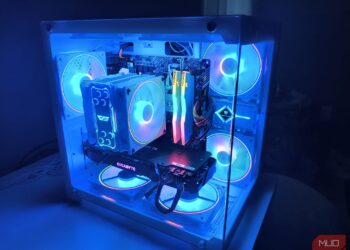Quick Links
Key Points
- AI faces challenges in generating text because of its historical input data and limited training resources.
- Utilize precise prompts, synonyms for “text,” and alternative tools for adding text.
- Keep text brief, resolve issues using other tools, and consider AI specifically designed for accurate text placement.
If you’ve experimented with AI tools for image creation, you’ve likely run into issues with text that just doesn’t look right. Understanding why this happens can help you navigate these challenges more effectively, and knowing some potential workarounds can be a game changer.
Why Can’t AI Generate Text in Images?
The primary reason AI struggles with generating text in images is the historical input data used for training. While AI has made significant strides in image generation, text has not been included in the training process to the same extent. This discrepancy leaves AI less proficient in producing readable text within images.
Even though AI has progressed significantly, we are still in the early stages of its development. Additionally, some AI tools may not have enough training data to generate text effectively right now. Thus, using a workaround to deal with these challenges is often necessary.
Are There Solutions for Unreadable Text in AI Images?
While it may be difficult to create text in images using AI, it is not entirely impossible. Here are some effective strategies I’ve found…
1. Provide More Specific Prompts to the Generator
When I first began using AI, my ability to craft prompts was pretty weak. Like many users, I fell into the trap of using vague instructions such as, “create an image of a street.” Naturally, this led to unsatisfactory outcomes.
The more detailed your prompts are, the better the results. For instance, a clearer prompt would be:
Create an image of the exterior of a charming Italian café featuring the sign “Café” on a bright sunny day.
This prompt yielded a much better image than simply requesting an “Italian café.” Keeping it specific aids the AI significantly.
From my experience, creating simpler images also tends to yield better results. The above image has fewer elements than one of my more complex attempts, making it easier for the AI to understand.
2. Experiment with Variants of the Word “Text”
I’ve noticed that altering the language in my prompts can lead to better outcomes. After using “text” repeatedly and getting nowhere, I began to explore synonyms.
Instead of just “text,” try these options:
- Title
- Letters
- Written words
- Sign
If these suggestions don’t meet your needs, keep experimenting with other alternatives. What works can vary based on your specific creation. For example, using “sign” wouldn’t be appropriate for a birthday card design.
3. Incorporate Text with Other Tools
If the text isn’t integral to your image, consider using different tools to add text later. This method is particularly effective for designs like cards or graphics.
When using this approach, ensure your image has ample space for text. Tools like Canva or Adobe Photoshop Express are great for layering text on AI-generated images, but many mobile apps also work well.
Make sure your chosen fonts complement the look and feel of your AI-generated design, and adjust everything as necessary to create a polished final product.
4. Keep Text Brief
In my experience, attempts to generate text in AI images often fail when I add too many words. When I try to create anything longer than ten characters, I usually encounter issues. So, similar to simplifying your images, keep your text as concise as possible.
Generate an image of a bank with the word “bank” on it, situated in a downtown area and resembling a modern structure typical of US cities.
The AI tool Generally performed well with this instruction, but I noticed some imperfections. I advise instructing the AI to focus on just one or two signs to minimize potential hiccups. Smaller text sizes seem to pose more challenges, so that’s something to consider as well.
5. Utilize Tools to Correct the Text
With these applications, you can typically select the problematic text and edit it as needed. While some apps are free, others may require a paid subscription. If you frequently generate images, investing in a monthly or annual plan might be worthwhile for continual access.
6. Select an AI Generator Capable of Producing Accurate Text
You may be familiar with tools like Midjourney, DALL-E, or Firefly, but did you know there are AI art generators designed specifically for creating images with readable text?
For example, Ideogram specializes in producing clear text. It’s worth trying out this app for some of your projects. Ideogram features a Magic Prompt option that enhances your original request, increasing the likelihood of receiving accurate results. Beyond the free plan, subscriptions start at $8 per month.
Despite the current limitations of generative AI in producing text within images, creative solutions can help. Thoughtful prompts with fewer words, utilizing external tools for text correction, or opting for AI generators tailored for text accuracy can significantly improve your results.








